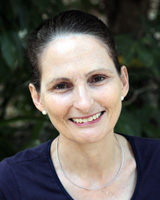Rural and remote Australia has a severe shortage of many different health professionals1-6 and the health of its people is relatively poor3,7-10. The 2012 National Strategic Framework for Rural and Remote Health emphasises the importance of a sustainable health workforce11. For more than two decades national and international studies have demonstrated an association between rural upbringing and a willingness to work in rural areas as a health professional12-18. This suggests that, if sufficient numbers of school students in rural and remote areas were given the opportunity to become health professionals, they would have the potential to alleviate this health profession shortage in the future. However, an often unrecognised consequence of the severe shortage of health professionals is the severe shortage of role models to inspire these school students to health profession careers19.
So, where do these school students obtain a picture of what it would be like to be a health professional? Do they acquire images from school? One of the functions of formal education is to prepare students for future roles in the society in which they live. For decades school curricula has been explained as what counts as justifiable knowledge20 and what is essential to be forwarded onto the next generation21.
Health career promotion in rural Australia is developing and has largely focused on middle to upper high school students22-25. This might seem logical given that university entry often closely follows the secondary school years. However, health career promotion in late secondary school may miss influencing suitable subject selection. In addition, this may be too late for many students and their families living in rural and remote areas to prepare for the additional financial, cultural, emotional, social and family costs associated with attending university hundreds of kilometres away, compared with costs for students and families living in university cities26-29. Furthermore, health career promotion in secondary school alone is neglecting crucial times in a child's career development.
Career development theorists generally agree that children start to shape ideas about potential careers long before secondary school30-35. Over recent decades a body of related literature has evolved - including two major reviews of research on career development in childhood - supporting the conceptualisation of childhood as vital in an individual's lifelong career development31,33-37. Career development theorists, such as Gottfredson and Watson, also agree that to aspire to a career a child must first know about that career31,34,35. Furthermore, when 55 000 students from 55 tertiary institutions in Australia were surveyed by the Australian Council for Educational Research, 40% of first-year tertiary students said they first considered university study while in primary school38.
This study explores distance-education primary students' exposure to information in the school curricula, pertinent to creating an interest in health profession careers, to make up for the lack of health professionals in their everyday lives.
Long distances between home and a conventional school means that many students living in rural and remote Australia cannot attend school in person. These students learn by distance education. The curricular materials are sent to them to study at home under the guidance of an adult, often their mother or a tutor.
All compulsory curricular materials provided by the Department of Education for study by rural and remote living distance-education students in years 3-7 of primary school in one Australian state were researched for content relevant to health profession careers. The study was interested in the quantity of content and how the content was portrayed.
As part of their learning, students and class peers (who are widely dispersed) have phone lessons with their teacher. It was not possible for the researcher to participate in these lessons. However, these are distance-education students so the majority of their learning is carefully and explicitly documented in the students' curricular materials. Furthermore, the phone lessons are based on these curricular materials.
The materials studied were audio files, audio-visual files, books produced by the Department of Education for the Language and Mathematics curricula, as well as compulsory commercially produced fiction and non-fiction books. The latter were known as resource books. Analysis of the materials took place from 2008 to 2011. With technological advances, some materials were slowly becoming available on CD and over the Internet. However, at the time of the study, most families were using the original hard copy version of the materials because of the cost and unreliability of the Internet in their location as well as the cost of having a functioning computer for each child in their home schoolroom. Therefore, to ensure authenticity and consistency, only the hard copy version of the materials was reviewed. The quantity of information was measured in whole pages and tenths of a page of text. Word count is not a practical unit of measure when reviewing hard copy material.
Only compulsory curricular materials were reviewed. Resources associated with 'optional activities' and language other than English (LOTE) choices (eg Italian and French) were not analysed. The Home tutor guides, a resource for the person who teaches the children, were not included in the data collection because the students did not work through these. They also repeated the content in the students' curricular materials.
All of the curricular materials were reviewed by one researcher, the author, as part of a PhD study. This researcher read every page of the printed material and listened to every audio and audio-visual file for students in years 3-7. Content, potentially related to students' capacity to become interested in the health professions as careers, was divided into information about health professions and information about the human body. It was argued that information about the human body, such as basic human anatomy and physiology, could stimulate a student's interest in a health profession career. Information about health professions included, for example, information about what they do (eg surgery), where they work (eg hospitals), and what they treat (eg diseases). The information about health professions was able to be further categorised as neutral, positive or negative according to how the information portrayed health professionals. Portrayals were assessed as positive if they presented health professionals as competent, helpful, approachable, caring, ethical or knowledgeable and they were assessed as negative if, for example, they presented them as incompetent, uncaring or unethical. The information about the human body was also categorised as neutral, negative or positive. Information was considered to be neutral if it was free of any affective implications, negative if it could discourage an interest in health profession careers and positive if it was considered to encourage an interest in a career in a health profession. If there was any uncertainty about the category for a piece of the curriculum an education expert in the area was consulted.
Ethics approval
This research received clearance from the James Cook University Experimental Ethics Review Committee (approval number H2899). Department of Education approval was also obtained.
In all, 5488 minutes of audio files, 809 minutes of audio-visual files, 15 905 pages of Language and Mathematics curricula books, and 8098 pages of resource books were analysed. These were the compulsory curricular materials studied by students in years 3-7 inclusive. In these materials only 0.1% and 0.9% of all the audio files, 1.9% and 0% of all the audio-visual files, 0.4% and 0.1% of all the Language and Mathematics curricula books and 0.5% and 0.4% of the resource books included information about health professions and the human body, respectively.
Tables 1 and 2 show the total quantity of information provided to students in each of years 3-7 in audio and audio-visual files respectively and the quantity of information about health professions and the human body in these files. The quantity of information about health professions and the human body was extremely small. Information about health professions in audio files ranged from nil in years 3, 6 and 7 to 4 minutes, and in audio-visual files from nil in years 3, 4 and 6 to 15 minutes in year 5. In the audio files the human body was only mentioned in year 3. There was no information about the human body in any of the audio-visual files.
Table 3 provides the total quantity of information for students in the Language and Mathematics materials produced by the Department of Education for years 3-7 and the quantity of information about health professions and the human body in these materials. Content mentioning health professions ranged from two-tenths of a page of text in all of year 3 to 39.6 pages in year 5. Content mentioning the human body ranged from none in year 6 to a maximum of 11 pages in year 3. The total quantity of information at each year level and the amount of information about health professions and the human body in the commercially produced fiction and non-fiction books studied by the students is detailed in Table 4. Once again the quantity of information mentioning health professions or human body was small.
All together, the curricula provided very little information to help students build an image of what it might be like to work in health profession careers (Tables 1-4). In each of the tables, the information about health professions and the human body is grouped according to the nature of its portrayal in the material (positive, neutral or negative). All the information about the human body was portrayed in a neutral manner; that is, no information about the human body was categorised in the positive or neutral groups, which respectively encourage or discourage a health profession career choice. Most of the information about health professions was neutral. Smaller amounts of information portrayed health professions in a positive or negative way. Although small, the information that painted a negative image of health professions was present in every year level (Tables 1-4), was explicit and mainly targeted doctors. In the resource books, 20% of the health profession content painted negative images of the profession. One book studied in year 5 had only one sentence that mentioned a health professional. The sentence read, 'Her last two children were born in the bush - one while her husband was bringing a drunken doctor, by force, to attend to her39 (p.14)'.
In another example taken from a different narrative studied in the same year level, Miss Lily, a school teacher, is in hospital when one of her students visits her home. The teacher's elderly neighbour breaks the news of Miss Lily's hospital admission to the student.
Miss Lily's gone to the hospital. Doctor reckons she's got to have some tests done. Them doctors are all the same. They can't stop jabbing in their needles and cutting bits out of you40 (p. 55).
Through the neighbour, students are exposed to judgemental views on what doctors do - 'can't stop jabbing in their needles' and 'cutting bits out of you'. These views are not balanced in their learning materials by any objective explanation about why these steps may be necessary in the diagnosis and management of patients. In addition, none of the information about health professions was presented in a manner that suggested to the students, 'this might be a career that you would enjoy', 'you could do this' or 'you could go on and become this professional in your community in the future'.
References to health professions in the curricular materials were mainly limited to doctors and nurses. Some health professions were not mentioned at all.
Table 1: Health profession and the human body content compared to total content for year in audio files
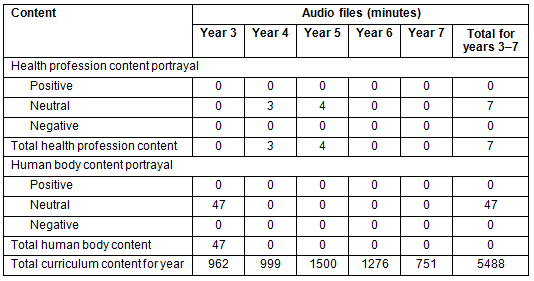
Table 2: Health profession and human body content compared to total content for year in audio-visual files
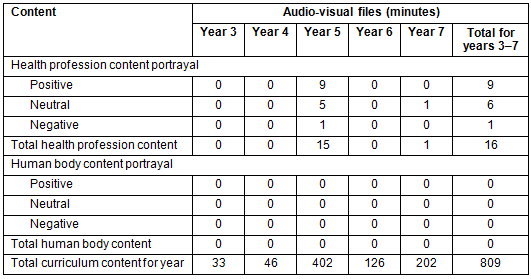
Table 3: Health profession and human body content compared to total content for year in Language and Mathematics books produced by the Department of Education
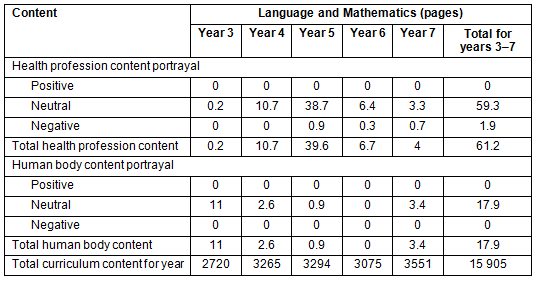
Table 4: Health profession and human body content compared to total content for year in resource books (pages)?
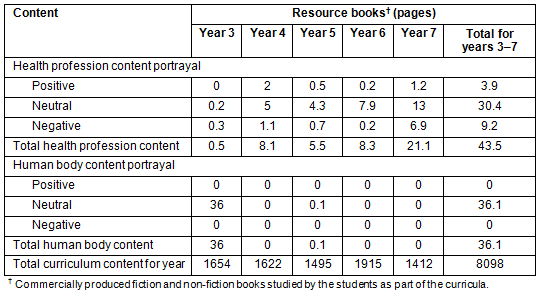
Discussion
The shortage of health professionals in rural and remote Australia is a multifactorial problem11. The professional and social isolation, the difficulties recruiting locums for personal and professional development leave, the long working hours and on-call load, limited career and lifestyle options and the educational and employment needs of other family members have all been listed by health professionals as deterrents to working in rural and remote areas11,17,41-43.
For some years research has indicated that health professionals who grew up in rural areas are more likely to return to work in rural areas than colleagues raised in the city12-14. School has a role to play in preparing students for future positions in their society21. Relatively few children from rural and remote areas of Australia enrol in health profession career courses44. This study is likely to be the first study of school curricular materials looking for content relevant to health profession careers. Given the apparent importance of the early years and of role models in shaping career decisions, the paucity of information about health professions or the human body identified in school learning materials may help to explain the chronic shortage of health professionals (and thus role models) in rural and remote Australia.1-6. What is exciting and important is that the situation seen in these findings is potentially modifiable and at little cost. For example, the thoughtful inclusion, from an early age, of a variety of examples of genre-embracing positive role models of diverse health profession careers in the Language and Mathematics units may help to fill the gap created by the shortage of health profession role models in rural and remote areas.
This study did not set out to criticise the distance education curricula, which must fulfil broad learning outcomes. However, if it was possible to work in collaboration with the Department of Education to change these findings, more students from rural and remote Australia may aspire to health professions. If these students and their families were then supported in their aspirations26-29, in the future Australia may be one step closer to alleviating the shortage of health professionals in these areas and one step closer to improving the health of the people who live there.
Limitations
It could be argued that there may be some subjectivity in determining the nature of the portrayal of health professions; however, the criteria were set out at the beginning to achieve consistency. All printed materials produced by the Department of Education (Table 3) were of uniform page and font size. In contrast there was some variability in the font and page size of the resource books (Table 4). Only a small number of the books were also available in digital form so a word count was not a practical alternative for the quantitative analysis of the content. Although this limits the accuracy of the quantitative review of the resource books (Table 4) the aim to gain an overall image of the frequency and nature of health profession and human body information in the curricula was still achieved.
Student exposure to health professions in the mass media (eg on television) was not measured. Such leisure activities are not controllable. It is possible that these children spend less time engaged with the media than city-dwelling school students because of the outdoor lifestyle of the families.
This study explored the information provided to students about health profession careers and the human body - before a student can aspire to a career they must first know that such a career exists30-37,45 . The author acknowledges that many other things impact on students' final career choices.
Distance-education school students in rural and remote Australia appear to have little opportunity to aspire to a health profession career. There are very few role models for these careers in their everyday lives. This research found insufficient information about health professions or the human body within the school curricula during crucial times in a child's career development trajectory to make up for the shortage of health professional role models. It is recommended that primary school curricula in rural and remote Australia include information about health professions. This information should be presented in a positive light and be thoughtfully and incidentally embedded into the curricular materials. The work of career development theorists suggests that this information should be part of the curricula from the beginning of primary education. Writers of curricula, who are mainly based in major cities, are the pathway to achieving this. They deserve the opportunity to understand the gravity of the shortage of health professionals in rural and remote Australia and the potential of school students living in those areas to be part of the future solution to the shortage.
This research should be repeated using the foundation to year 10 Australian Curriculum that it is being implemented in all states and territories46. If digital versions of all the curricular materials studied by students are available, these ought to be reviewed so that word count of health profession content could be the unit of measure for the quantitative analysis. Future studies could explore responses to interventions implemented.
For decades the severe shortage of health professionals in rural and remote Australia has been a burden on the people who live there, and for health professionals. Previous research has repeatedly demonstrated that health professionals most likely to work in rural and remote areas are those raised in those areas. Career development theorists argue that children start to develop ideas about future careers before they start school and continue to shape these ideas throughout primary and secondary school. Currently, school students in rural and remote Australia have few role models and virtually no information about health professions at crucial times in their school curricula to shape their career aspirations to these professions. What is exhilarating about this analysis of the school curricula is that the findings are modifiable at relatively little cost. Maximising opportunities for school students who live in rural and remote Australia to aspire to health professions has potential for future rural health workforce recruitment.
Acknowledgement
The author gratefully acknowledges the support of the Schools of Distance Education, their families and teachers; Professor Nola Alloway, Associate Professor Melissa Vick, for PhD supervision; Associate Professor Ralph Pinnock, for reading an early version of this article; Associate Professor Louise Young, for advice and encouragement; and James Cook University, Queensland Government Growing the Smart State PhD program and Royal Australasian College of Physicians Foundation, for PhD support.
References
1. Australian Institute of Health and Welfare. Health workforce overview 2011. (Online) 2011. Available: http://www.aihw.gov.au/health-workforce (Accessed 20 March 2012).
2. Deloitte Access Economics. Review of the rural medical workforce distribution programs and policies. Department and Health and Ageing 2011. (Online) 2011. Available: https://www.health.gov.au/internet/main/publishing.nsf/Content/foi-disc-log-2011-12/ (Accessed 31 May 2012).
3. Australian Institute of Health and Welfare. Australia's health 2014. (Online) 2014. Available: http://www.aihw.gov.au/publication-detail/?id=60129547205 (Accessed 22 October 2014).
4. Cooke B. President's address: Pastorale. Medical Journal of Australia (Supplement) 1968; 1(3): 15-18.
5. Bureau of Transport and Regional Economics. Skills shortages in Australia's regions. Working paper no. 68. Canberra, ACT: Australian Government, 2006.
6. National Health Workforce Taskforce. Health workforce in Australia and factors for current shortages April 2009. (Online) 2009. Available: http://www.ahwo.gov.au/publications.asp (Accessed 22 December 2014).
7. Australian Institute of Health and Welfare. Impact of rurality on health status. (Online) 2011. Available: http://www.aihw.gov.au/rural-health-impact-of-rurality/ (Accessed 8 August 2011).
8. Australian Institute of Health and Welfare. Australia's health 2012. Available: http://www.aihw.gov.au/WorkArea/DownloadAsset.aspx?id=10737422169 (Accessed 7 July 2012).
9. O'Callaghan AM, McAllister L, Wilson L. Barriers to accessing rural paediatric speech pathology services: health care consumers' perspectives. Australian Journal of Rural Health 2005; 13(3): 162-171.
10. Underhill C, Goldstein D, Grogan P. Inequity in rural cancer survival in Australia is not an insurmountable problem. Medical Journal of Australia 2006; 185(9): 479-480.
11. Australian Health Ministers' Advisory Council's Rural Health Standing Committee. National strategic framework for rural and remote health. (Online) 2012. Available: http://www.ruralhealthaustralia.gov.au (Accessed 31 May 2012).
12. Laven GA, Wilkinson D. Rural doctors and rural backgrounds: how strong is the evidence? A systemic review. Australian Journal of Rural Health 2003; 11(6): 277-284.
13. Strasser R. Attitudes of Victorian rural GPs to country practice and training. Australian Family Physician 1992; 21(7): 808-812.
14. Wilkinson D, Beilby JJ, Thompson DJ, Laven GA, Chamberlain NL, Laurence CO. Associations between rural background and where South Australian general practitioners work. Medical Journal of Australia 2000; 173: 137-140.
15. Henry JA, Edwards BJ, Crotty B. Why do medical graduates choose rural careers? Rural and Remote Health 9: 1083. (Online) 2009. Available: www.rrh.org.au (Accessed 20 December 2014).
16. McGrail MR, Humphreys JS, Joyce CM. Nature of associations between rural background and practice location: a comparision of general practitioners and specialists. BioMedical Central Health Services Research 2011; 11(63): 1-8.
17. Rogers M, Searle J, Creed P. Why do junior doctors not want to work in a rural location: and what would induce them to do so? Australian Journal of Rural Health 2010; 18: 181-186.
18. Humphreys JS, Prideaux DJ, Beilby JJ, Glasgow NJ. From medical school to medical practice: a national tracking system to underpin planning for a sustainable medical workforce in Australasia. Medical Journal of Australia 2009; 191(5): 244-245.
19. Gorton S. Health careers education for rural primary school children. Australian Journal of Career Development 2011; 20(1): 5-13.
20. Bernstein B. On the classification and framing of educational knowledge. In MFD Young (Ed). Knowledge and control: new directions for the sociology of education. London: Collier-Macmillan, 1971; 47-69.
21. Lovat T. What we learn about yesterday, today, and tomorrow. Tracking social movements through curriculum analysis. In J Allen (Ed). Sociology of education: possibilities and practices. Katoomba: Social Science Press, 2001; 88-106.
22. Alexander C, Fraser J. The promotion of health careers to high school students in the New England health area: the views of high school careers advisers. Australian Journal of Rural Health 2001; 9: 145-149.
23. Fraser J, Alexander C, Simpkins B, Temperley J. Health career promotion in the New England Area of New South Wales: a program to support high school career advisers. Australian Journal of Rural Health 2003; 11: 199-204.
24. Hindmarsh N. Career workshop recruits rural high school students to health professions. (Online) 2006. Available: http://www.uq.edu.au/news/index.html?article=1107 (Accessed 23 August 2006).
25. National Rural Health Students' Network. Rural high school visit inspiring the future of rural health: what is a RHSV? (Online) 2015. Available: http://www.nrhsn.org.au/activities/rural-high-school-visits/ (Accessed 2 September 2015).
26. Alloway N, Gilbert P, Gilbert R, Muspratt S. Factors impacting on student aspirations and expectations in regional Australia. Canberra, ACT: Commonwealth of Australia, 2004.
27. Cripps S. Country Education Foundation of Australia and the Origin Foundation form partnership to support rural youth. News and views: Isolated Children's Parents' Association Queensland Inc. 2011; 25(2): 13.
28. Durey A, McNamara B, Larson A. Towards a health career for rural and remote students: cultural and structural barriers influencing choices. Australian Journal of Rural Health 2003; 11: 145-150.
29. National Rural Health Alliance. Good health and wellbeing in rural and remote Australia: further education and health. (Online) 2010. Available: http://www.ruralhealth.org.au (Accessed 8 January 2014).
30. Gottfredson LS. Using Gottfredson's theory of circumscription and compromise in career guidance and counseling. In SD Brown, RW Lent (Eds). Career development and counseling: putting theory and research to work. New York: Wilky, 2004; 1-50.
31. Watson M, McMahon M. Children's career development: a research review from a learning perspective. Journal of Vocational Behavior 2005; 67: 119-132.
32. Watson M, McMahon M. Children's career development: metaphorical images of theory, research and practice. Career Development Quarterly 2008; 57(1): 75-83.
33. Hartung P, Porfeli E, Vondracek F. Child vocational development: a review and reconsideration. Journal of Vocational Behavior 2005; 66: 385-419.
34. Gottfredson LS. Circumscription and compromise: a developmental theory of occupational aspirations. Journal of Counseling Psychology Monograph 1981; 28(6): 545-579.
35. Gottfredson LS. Gottfredson's Theory of circumscription, compromise, and self-creation. In: Brown D, Associates (Eds). Career choice and development, 4th edn. San Francisco: Jossey-Bass, 2002; 85-148.
36. McMahon M, Rixon K. The career development of rural Queensland children. Australian Journal of Career Development 2007; 16(2): 39-50.
37. Watson M, McMahon M, Foxcroft C, Els C. Occupational aspirations of low socioeconomic black South African children. Journal of Career Development 2010; 37(4): 717-734.
38. Australian Council for Educational Research. Setting primary course for university study. (Online) 2010. Available: https://www.acer.edu.au/media/article/setting-primary-course-for-university-study (Accessed February 2011).
39. Lawson H. The drover's wife. Melbourne, VIC: Rigby Education, 1988.
40. Kidd D. Onion tears. Sydney, NSW: Harper Collins, 1990.
41. Wilson N, Couper I, De Vries E, Reid S, Fish T, Marais B. A critical review of interventions to redress the inequitable distribution of healthcare professionals to rural and remote areas. Rural and Remote Health 9: 1060. (Online) 2009. Available: www.rrh.org.au (Accessed 5 June 2012).
42. Jinhu L, Scott A, McGrail M, Humphreys J, Witt J. Retaining rural doctors: doctors' preferences for rural medical workforce incentives. Social Science & Medicine 2014; 121: 56-64.
43. Buykx P, Humphreys J, Wakerman J, Pashen D. Systematic review of effective retention incentives for health workers in rural and remote areas: towards evidence-based policy. Australian Journal of Rural Health 2010; 18: 102-109.
44. Bradley D, Noonan P, Nugent H, Scales B. Review of Australian higher education: final report. (Online) 2008. Available: http://www.mq.edu.au/pubstatic/public/download.jsp?id=111997 (Accessed 1 December 2014).
45. Johnston S. Girls making choices about careers: the importance of personal experience. Australian Journal of Social Issues 1994; 29(4): 334-345.
46. Australian Curriculum Assessment and Reporting Authority. Australian curriculum. (Online) 2014. Available: http://www.australiancurriculum.edu.au (Accessed 10 December 2014).
